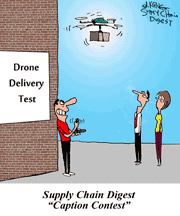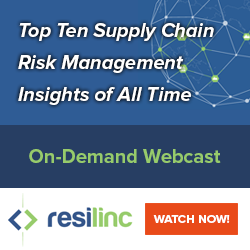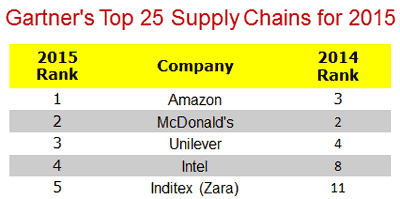 |
May 21, 2015 - Supply Chain Flagship Newsletter |
 |
| FEATURED SPONSOR: RESILINC |
||
 |
||
Download the Ultimate Guide to Supply Chain Resiliency Program Success! |
 |
|
||||||||||||||||||||||||||||||||||||||||||||||||||||||||||||||||||||||||||||||||||||||||||||||||
The former AMR Research brilliantly came up with the top 25 idea in 2004. Gartner then acquired AMR in 2010. Over the last few years, the concept has been extended, so that we now have a "Next 25," a top 25 healthcare supply chains, top 25 industrial supply chains, and maybe some others I have missed. So this year, I asked around a bit, and found - not surprisingly - that very few supply chain managers have any real idea how the list is created. They only know if they are in or they are out, and that's about all that matters.
This year for the first time Amazon came out on top, after Apple had grabbed the top spot for a few years running. Somewhat oddly, to my view, Apple and Procter & Gamble were left off the top 25 this year because they have been consistently near the top of the list. So both those companies have now been placed in a separate new category, called "supply chain masters," a sort of "hall of fame" we might say.
Not sure the reasoning behind this. It frankly may have to do with in effect getting more companies in the top 25 plus the new master's category - Gartner clients like that recognition, of course. Was the move in reaction to some criticism last year from an ex-AMR/Gartner executive, who said the top 25 was becoming boring because it changed so little?
Regardless, this new construct seems to me something that will be tough to manage over the years. If P&G stumbles, will it be moved out of the masters list but maybe still be in the top 25? Will the masters list grow and grow over time, so that we have these competing masters and top 25 lists each year?
With Apple and P&G withdrawn from the competition, the rest of the top 10 was number 2 McDonald's, followed by Unilever, Intel, Inditex (Zara), Cisco, H&M, Samsung, Colgate-Palmolive and Nike. L'Oreal, Toyota and Home Depot rejoined the top 25 this year. In addition to Apple and P&G, Caterpillar dropped off.
Here is a quick visual of the top 5 for 2015, with a link to the full chart of all 25 companies: |
|||||||||||||||||||||||||||||||||||||||||||||||||||||||||||||||||||||||||||||||||||||||||||||||||
So, how on earth is the top 25 determined? ROA and revenue growth use a three-year weighted average, meaning the most recent year gets the most weight and the two prior years somewhat less. Inventory turns, smartly, uses the prior year's quarterly average (reducing impact of end of year games). These three metrics together are given a full 50% of the total score weight (25% to ROA, 15% to turns, and 10% to revenue growth). Now keep in mind that this formula gives a tremendous advantage to some companies, such as Amazon given its huge revenue growth or McDonald's and its 157 inventory turns per year. It also penalizes companies like a Home Depot or a Lowes, for example, which are only going to have turns in the mid-single digits, because of their need to stock every item under the sun to meet customer service goals, many of which are very slow movers. In general, this approach also penalizes a company within a given sector that strategically decides on a higher service, lower turns strategy (even though we can all agree that inventory efficiency is a very important attribute of supply chain excellence).
Companies that have heavily outsourced production and distribution also have an inherent advantage. Why? Because they have chosen to shed assets, and that drives their ROA metric higher. While outsourcing can be a very smart thing for many reasons, it is not inherently a better supply chain move. This metric also inherently discriminates against asset-intensive businesses, such as chemicals and automotive. That no doubt why we see only three such companies (3M, Cummins, and Toyota) in the top 25, towards the end of the list, and probably a big factor in having the separate list of the top 25 industrial supply chains.
From those selections, respondents are then asked to rank those companies from first to last, from which points are assigned to companies making that cut.
And it is a bit mysterious - while Amazon has strong revenue growth, it had 0% ROA and a middling 8.7 inventory turns, yet it somehow winds up on top even though those two measures account for 40% of the total score. It did have by far the top score in the peer rankings, I will note, so I guess that's what did it. Amazon is an innovator, that's for sure, and spends a lot of money on facilities and technology, but DDVN orchestration is not something I associate with Amazon. |
|||||||||||||||||||||||||||||||||||||||||||||||||||||||||||||||||||||||||||||||||||||||||||||||||
|
|||||||||||||||||||||||||||||||||||||||||||||||||||||||||||||||||||||||||||||||||||||||||||||||||
|
|||||||||||||||||||||||||||||||||||||||||||||||||||||||||||||||||||||||||||||||||||||||||||||||||
|
|
|
YOUR FEEDBACK
We received a good number of comments after we recently updated our list of the top 12 supply chain innovations of all-time. You will find a sampling below. We'll publish some more next week.
Feedback on Top Supply Chain Innovations of All-Time:
No. 6 - The Universal Product Code: Though the idea to use some form of printed and even wireless automatic product identification had been around for decades, lack of standards had precluded individual ideas from gaining any sort of critical mass. In 1970, a company called Logicon wrote a standard for something close to what became known as the Universal Product Code (UPC) to identify via a bar code a specific SKU, an effort that was finalized a few years later by George Laurer at IBM. The first implementation of the UPC was in 1974 at a Marsh's supermarket in Troy, OH north of Dayton. The invention triggered the auto ID movement, forever changing supply chain practice and information flow. Interestingly, Computer Identics' October 1971 deployment of a laser scanner for inventory tracking at Buick soon followed by use of the technology for warehouse management at General Trading (New Jersey) and Kroger (Nashville) predates UPC and, with the latter, laid the foundation for broader use of automatic identification throughout the supply chain. John M. Hill
|
||
That's a good list and of course it was great to see our Continuous Replenishment Program (CRP) and CPFR included. Some others than had a significant industry impact were Total Order Management (TOM), The Perfect Order and Streamlined Logistics Pricing (SLOG).
|
||
I would suggest that two other developments belong on the list: Bill Pritz |
SUPPLY CHAIN TRIVIA ANSWER
Q: What iconic operations term was first used in a journal article by MIT researcher John Krafcik in 1988?
A: "Lean," Krafcik's term for the Toyota Production System.
| © SupplyChainDigest™ 2003-2015. All Rights Reserved. SupplyChainDigest PO Box 714 Springboro, Ohio 45066 |
POWERED BY: XDIMENSION
|









